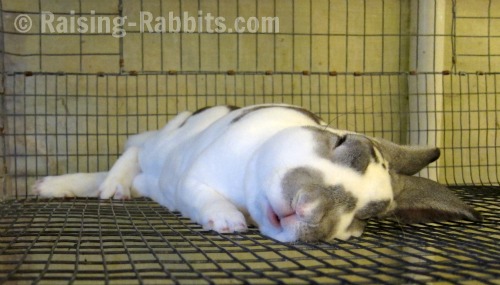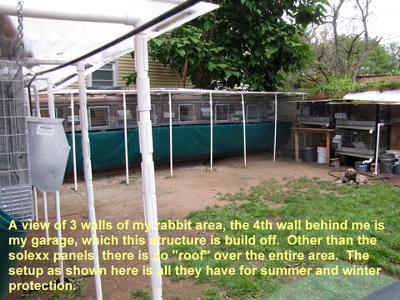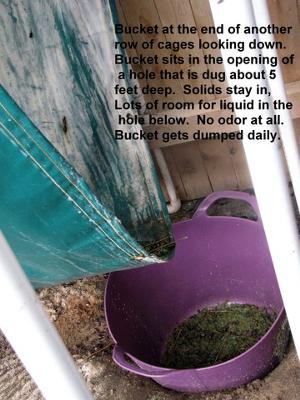Rabbit Rhythms of November
How Long do Rabbits Live?
Rainbow Bridge Pets
"Rainbow Bridge" sounds peacefully poetic, despite the fact that the term is well recognized as a euphemism for the death of a beloved pet.
Death hurts, and sometimes all the more when we can see its approach.
"I think my 10-year-old dwarf bunny is dying," wrote Kelly from South Carolina. "About a month ago, she fell over and needed help to get up, but seemed otherwise fine. I saw no other symptoms and she resumed her usual activities. Four weeks later, Bunny is no longer eating. She only drinks with assistance. She is breathing normally but will not sit up; she just lies on her side...."
At 10 years old, Kelly's bunny is already on borrowed time, though it is rare but not unheard of for rabbits to live to 11-14 years of age.
(The rainbow bridge is thankfully far away from this sleeping rabbit.)

Why do Healthy Rabbits Die?
Despite the best of care, death inevitably comes, even to the healthiest of rabbits, and here is why.
The hormone system, which helps to modulate the immune system, peaks its output at around 6 months of age. Thereafter, the hormone levels slowly drift southward. The rabbit's vigor is strong enough for 2-3 years of reproductive activity, after which it hits middle age. At around 4 years of age, the female rabbit may only be able to sustain an occasional litter, and by 5 years of age, probably cannot conceive at all.
At any time after 3-4 years of age, the immune system begins to progressively weaken as the hormone levels continue to drop.
Death typically arrives somewhere between 6-8 years of age for both bucks and does. This occurs at the point at which the immune system can no longer keep up with the daily chores of repairing inflammation or sustaining life, even if the rabbit seems to be completely healthy.
As you recognize what appears to
be an irreversible decline in health, a vet check as soon as possible might help to provide a diagnosis of either old age or disease. Perhaps there is a means of staving off death for a while longer. If there are no solutions, then he or she can help you send your rabbit to rest beyond the rainbow bridge if in your opinion the time has come.
Overheard ...
“Karen, your book [Rabbit Raising Problem Solver] has the most readable voice, and the most accessible information – I love it, and I’m not even interested in rabbits! (Yes, they’re cute – they’re adorable. Period.) Congratulations! Everybunny who loves a body should have this book!!”
That was from Showandah, an author-friend who knows good writing. From ‘somebunny’ who dishes complements only when merited, that said a LOT, and was very appreciated.
From Terrie in California:
“Great information [on Raising-Rabbits.com]. Glad I found this site. I'm really new at rabbits, just got a rabbit today. Your information helped me decide on the type, size--good research information. Thanks. Really like the straight forward presentation backed up by facts and actual experience.”
From Cindy in North Carolina:
“I love your info, thank you. We're raising an Eastern Cottontail that my husband brought home. She was beside the
road; is very small but ate rabbit pellets and celery. I gave her a salt wheel, and take her outside in her cage and set her down in clover and grass. Had her a month, she is growing fast and seems relaxed.”
Thank you for sharing your thoughts and compliments!
Rabbits in the News
Rabbit Urine Fertilizer brings additional income to
Kenyan farmers
(2018 Update: The original DailyTimes.com article is no longer available online, but the ideas outlined below are worth consideration.)
It appears that Kenyan farmers are being educated to manage their farms and crops in a brilliantly sustainable way.
 Instead of purchasing fertilizer for their fields, rabbit owners and breeders are learning how to collect rabbit urine by the liter, use some of it in their own fields, and sell the overages, gaining an additional source of income for their families. Instead of purchasing fertilizer for their fields, rabbit owners and breeders are learning how to collect rabbit urine by the liter, use some of it in their own fields, and sell the overages, gaining an additional source of income for their families.
The farmer featured in the above news report collects on average 16 liters of rabbit urine every day using slanted drop pans which feed into a gutter system. He feeds his vegetables with some of the liquid gold,
and sells the rest.
You may be able to do the same by adapting ideas from my friend Lisa’s set-up to suit your own situation. (See both pictures at right.)
 Lisa lets the urine drain away into the ground in order to minimize odors, as her neighbors live only a few yards away. Instead, collect the urine in a second barrel under the perforated one which collects the solids. Emptied into the garden and rinsed daily, the modifications should result in no additional smells.
Lisa lets the urine drain away into the ground in order to minimize odors, as her neighbors live only a few yards away. Instead, collect the urine in a second barrel under the perforated one which collects the solids. Emptied into the garden and rinsed daily, the modifications should result in no additional smells.
Have just a couple house pets? Try using a safe, biodegradable litter in the litter pan, and then using
the wastes sparingly in house plants or in the garden.
Your friends will marvel at your green thumb and may even beg you for some of your magic!
Like this newsletter?
Maybe your friends would too...
Your friends at Raising-Rabbits.com wish you a wonderful November, 2014.
Happy Autumn, and enjoy your rabbits!
|

